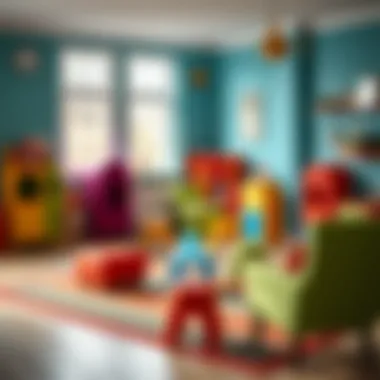Designing a Playroom: Tips for a Fun and Safe Space


Intro
Designing a playroom is not merely about slapping down some carpet and tossing in a few toys. It's an intricate dance between creating a pleasant atmosphere and ensuring safety, not to mention keeping functionality high on the priority list. A well-executed playroom is a haven where kiddos can explore their imaginations, while the guardians breathe easy knowing they are in a secure environment. The process calls for thoughtful strategies, from how the space is organized to the types of materials chosen.
Creating a backdrop that encourages creativity is vital. Young minds flourish in spaces that spark their curiosity and reflect their personalities. If you're on a journey to craft a stimulating playroom, you've come to the right place. This guide tackles the nitty-gritty of playroom design, touching on aspects ranging from current design trends to furniture selection, and much more. Whether you’re a homeowner, an interior designer, or a DIY enthusiast looking to create the ultimate playful environment, these insights cater to a broad audience.
As we delve deeper into the subject, expect to find practical tips, compelling examples, and clear guidelines. The aim is for you to walk away with a rich understanding of what makes a playroom not just functional, but also an inviting sanctuary for imagination. So, let's roll our sleeves up and jump into the vibrant world of designing a playroom that is as safe as it is enchanting.
Design Trends
Current Trends in Furniture Styles
In recent years, there has been a noticeable shift in furniture styles geared towards playrooms. Minimalism is all the rage; furniture pieces are often sleek, lightweight, and easy to move around. Think about modular designs—ones that can be reconfigured quickly. This flexibility is a boon, especially when the kids decide to rearrange play areas on a whim.
Additionally, natural materials are making a comeback. Items made from wood not only add warmth but also provide a sturdiness that is often required in children's environments. Bright colors aren't going anywhere but are often used in moderation. Instead, soft, inviting palettes seem to be trending, allowing vivid toys to pop without overwhelming the senses.
To add depth, textured elements like woven baskets or plush rugs can further enhance the aesthetic while remaining practical.
How to Incorporate Trends into Your Space
Incorporating these trends into your playroom can be a rewarding challenge. Start by evaluating existing furniture you may already have. Can it fit into a minimalist aesthetic? If not, consider swapping it for newer, versatile pieces. Here are a few suggestions:
- Mixing Heights: Use varied heights for furniture. Low tables enable kids to reach their toys easily while taller cabinets can store items away safely.
- Create Zones: Designate separate areas for different activities like reading, crafting, or active play. Zoning helps kids focus and gives a sense of order.
- Bring Nature Inside: Integrate plants into your design. Not only do they purify the air, but they also create a soothing ambiance. Choose non-toxic options like spider plants or pothos.
“A child’s play area should reflect not just their hobbies, but also be a soft retreat where they can engage in their worlds.”
Buying Guides
Choosing the Right Furniture for Different Rooms
When it comes to picking out furniture, it’s essential to assess what kind of activities will take place. For more subdued play, consider low-seating options like bean bags or floor cushions. On the flip side, if energetic and active games are the focus, a sturdy table for crafts and a floor area for rolling around should be prioritized.
Consider also the height of furniture. When selecting tables or chairs, keep child ergonomics in mind to ensure they can use the furniture comfortably without straining themselves.
Tips for Assessing Quality and Value
Quality can greatly influence both the safety and longevity of playroom furniture. Look for pieces that:
- Have Rounded Edges: Sharp edges can pose safety risks; rounded edges help protect little ones from injuries.
- Are Made from Durable Materials: Consider options like plywood or reinforced plastic rather than MDF which may not hold up to wear and tear as well.
- Meet Safety Standards: Always check that furniture adheres to national safety standards. This is key to ensuring that your playroom is both functional and secure.
Understanding the Purpose of a Playroom
Designing a playroom goes beyond decorating a child’s space; it’s about creating an environment that fosters creativity, learning, and development. A well-thought-out playroom serves as a sanctuary for imagination, where children can play freely and explore their interests. Understanding the purpose of a playroom is fundamental to ensuring it meets the needs of the child, and these needs evolve as they grow. The playroom should invite children to engage in activities that stimulate their minds and bodies while also being a place that parents feel comfortable leaving them to play.
Defining Playroom Objectives
To create a successful playroom, one must first set clear objectives. What do you want this space to achieve? Generally, you might have several aims:
- Encourage Creativity: Providing materials like art supplies, building blocks, or even a simple chalkboard can inspire children to express themselves artistically.
- Promote Social Interaction: A playroom can serve as a space for children to gather with friends, encouraging teamwork and communication.
- Facilitate Learning Through Play: Incorporating educational toys and resources can enhance cognitive skills in a fun way, allowing children to learn without the pressure of a formal environment.
- Create a Safe Haven for Physical Activity: Playrooms should include areas where children can be active, such as small climbing structures or open spaces for movement.
Setting objectives not only helps in designing the space but also aligns it with developmental goals. It’s crucial to remember that expectations should adapt as children grow. For instance, younger kids might need more space for physical play, while older children could benefit from distinct zones dedicated to specific activities.
The Role of Play in Child Development
Play is an essential component of childhood development. According to experts, it’s through play that children learn about the world around them. It helps in several key developmental areas:
- Cognitive Development: Engaging in problem-solving activities, like puzzles or building sets, hones critical thinking skills. Children begin to understand cause and effect, improving their decision-making abilities.
- Emotional Growth: Play allows children to navigate their emotions, whether it’s joy, frustration, or curiosity. Role-playing games can help them express their feelings and develop empathy towards others.
- Physical Skills: Movement-based play enhances motor skills, coordination, and balance. Even something simple like jumping on a soft mat can contribute to their physical development.
- Social Skills: Cooperative games encourage children to communicate, share, and resolve conflicts, fostering relationship-building skills that are crucial later in life.
Ultimately, the purpose of a playroom should center around maximizing the benefits of play, enabling children to grow, learn, and develop holistically. A well-designed playroom becomes more than just an area for toys; it transforms into a dynamic space for personal and social development.
"Play is the highest form of research." – Albert Einstein
Taking the time to understand these objectives and the role that play has in development will guide you in crafting an inviting playroom that nurtures a child’s full potential.
Assessing the Available Space
Assessing the available space is a crucial step in designing an inviting playroom. This process goes beyond merely measuring the room's dimensions. It involves understanding how the size and layout of the space can influence the kind of play experiences you can offer. When you have a clear frame of reference for the space, you can ensure that each play zone is functional and purposeful. A well-planned area can nurture creativity, provide comfort, and enhance the overall play experience.
Evaluating Room Size and Layout
When it comes to evaluating room size and layout, it’s all about getting the most out of what you have. A smaller room doesn’t mean you��’re limited in options. Instead, it could inspire creativity in your design choices. Consider how to maximize floor space while maintaining a sense of flow. Aim for a layout that promotes easy movement, avoiding clutter that's more nuisance than necessity. Think about furniture placement that encourages interaction among children.


Much like a puzzle, arranging furniture in the right way can free up more areas for play and creativity. Often, it can help to sketch a floor plan before making any decisions. When furniture is arranged wisely, there’s more room for different activities without stepping on each other's toes.
Additionally, incorporating natural light is key. If the room has windows, do not shy away from positioning seating or play areas near them. Children thrive in environments where they can bask in the sun, so allowing for bright spaces can uplift moods.
Determining Suitable Locations
Deciding on suitable locations for your playroom is another important aspect. A playroom doesn't need to be confined to a traditional space like a dedicated bedroom or basement. You may find an overlooked corner of the living room or a sunlit area of the den could become an ideal play space. Think outside the box; if you have an attic or a large garage, those spaces might work well with a bit of creativity.
Factors like proximity to the main living areas, safety, and ease of supervision should weigh heavy in your decision-making. A playroom ideally should be visible from key areas, enabling parents to keep an eye on things without hovering.
Involving children in the decision can also be valuable. Their input about their preferences for space can provide insights into what would motivate them to engage with the playroom. As their routines and interests evolve, choosing a versatile location can make it easy to adapt your design as necessary.
In summary, properly assessing the available space sets the stage for a successful playroom. It ensures the play environment is not just functional but genuinely inviting, allowing for a treasure chest of opportunities for kids to discover and explore their creativity.
Choosing Appropriate Furniture
Selecting the right furniture is a cornerstone of any effective playroom design. It not only enhances the room's aesthetic but also plays a pivotal role in functionality, safety, and adaptability. When you think about how much time children spend in their playroom, investing in proper furniture becomes paramount.
The furniture sets the tone of the space, making it either inviting or drab. It needs to facilitate various types of play, from quiet reading to energetic play, while also ensuring a safe environment for the little ones. By keeping in mind the various activities and age groups that will utilize the space, homeowners can choose pieces that promote not just play, but also exploration and learning.
Here are some specific elements to consider when deciding on furniture:
- Versatility: Look for furniture that serves multiple purposes—like a bench that stores toys or a table that can serve for crafts or snack time.
- Easy to Clean: Children can be messy. Choose materials that are wipeable or washable to ensure the furniture maintains its appeal over time.
- Proportions: Scaling is important. Ensure that all pieces are appropriately sized for your child’s age group to encourage independence.
Types of Furniture for a Playroom
When it comes to furnishing a playroom, there’s a myriad of options, from vibrant bean bags to sturdy shelving units. Below are some essential types of furniture to consider:
- Seating: This could range from soft cushions that can be easily moved around to miniature chairs that are sized for toddlers. Consider colorful, fun designs that spark joy.
- Tables: A low-height table can serve many functions, whether it's for building blocks, art projects, or snack time. Round tables can also promote social interaction.
- Storage Units: Implement bookshelves or toy bins with labels that children can understand. This not only organizes the space but encourages kids to be responsible for their belongings.
- Play Structures: Depending on your space, consider adding small climbing structures or play tents that stimulate physical activity and imaginative play.
- Art Stations: A small easel or a craft table can encourage creativity, offering a designated area for drawing and other craft activities.
Selecting Child-Safe Materials
Child safety is a non-negotiable consideration when choosing furniture. Not only must the materials be sturdy, but they should also be free of harmful substances that could pose risks to young ones. Here’s what to prioritize:
- Non-Toxic Finishes: Look for furniture finished with water-based paints or natural oils. This reduces the risk of exposure to harmful chemicals.
- Rounded Edges: Furniture should be designed with soft, rounded edges to minimize injury should a child tumble or bump into something unexpectedly.
- Durability: Choose materials that withstand wear and tear. Solid wood or high-quality plastics can offer longevity, while fabrics should be resistant to stains and easy to clean.
Ergonomic Considerations in Design
Ergonomics isn’t just for adults; children also benefit greatly from furniture designed with comfort and body mechanics in mind. Proper ergonomics in a playroom can lead to better posture, enhanced learning, and overall well-being. Here are points to consider:
- Proper Sizing: Ensure that all furniture is appropriate for each age group. Too high or low seats can lead to discomfort and affect how children engage with their activities.
- Supportive Design: Chairs should offer some back support, even if it’s just to encourage good posture as children sit for various activities.
- Mobility: Lightweight furniture that can be easily moved will encourage children to reconfigure their play spaces and promote physical activity.
"A well-thought-out playroom environment not only entertains but also nurtures growth and creativity."
Integrating Play Zones
Integrating play zones within a playroom is a fundamental aspect of design that can significantly enhance a child's play experience. When thoughtfully arranged, these zones cater to diverse activities, allowing children to explore and engage their creativity fully. It also reduces clutter by giving clear purposes to different areas, making it easier for children to organize their playtime and for adults to maintain the space.
Creating Distinct Areas for Different Activities
Creating distinct areas tailored for specific activities is vital in framing the overall functionality of a playroom. Children thrive in environments that provide varied stimuli, and by segmenting the space into zones, it encourages them to transition between imaginative play, quiet reading, or hands-on crafts freely.
For instance, you might designate a corner for art with an easel, paints, and a soft surface to catch any spills. Adjacent to this, a reading nook with bookshelves and cushions can foster an inviting area for winding down. The separation helps children understand boundaries and develop various skills simultaneously. Here are a few popular zones to think about:
- Creative Zone: Crafting supplies, drawing materials, and games that invoke artistic expression.
- Active Zone: Soft play mats or climbing structures for physical activities, essentially a mini obstacle course.
- Cognitive Zone: Puzzles, board games, and quiet toys that encourage problem-solving abilities.
These designated areas should ideally blend seamlessly while remaining distinctly identifiable, and using vibrant colors or playful rugs can help in differentiating them without causing confusion.
Using Furniture to Define Spaces
Furniture plays a pivotal role in defining play zones, serving both functional and aesthetic purposes. Choosing the right pieces makes it easier to structure activity areas clearly. For example, low shelving units can double as a room divider while also granting easy access to toys arranged neatly. Instead of a traditional table, you might select a modular piece that can be rearranged effortlessly to accommodate various activities, from arts and crafts to group games.
A few considerations for selecting furniture include:
- Age Appropriateness: Ensure that all pieces are suitable for the age range of children who will be using the space.
- Multi-functionality: Opt for items that serve multiple purposes, such as ottomans that can store items inside and provide seating.
- Safety and Comfort: Avoid sharp edges or unstable structures, prioritizing stability and ease of use for small hands.
Placing furniture strategically can also help direct the flow of movement within the playroom, steering children where they can focus and enjoy their activities without feeling constrained.
"A well-designed play space isn’t just about toys; it’s also about how children feel in those spaces. When they can choose where to play, they become more engaged and happy in what they do."
Color and Aesthetics in Playroom Design


The aesthetic aspects of a playroom transcend mere visual appeal; they weave into the very fabric of a child's recreational experience. Colors ignite creativity, nurture emotional stability, and can even influence behavior. An inviting playroom, rich in color and aesthetic appeal, aids in creating an environment conducive to imagination and exploration. When selecting colors and design elements, it’s essential to consider not only beauty but the psychological effects that different hues can invoke in children.
In a space dedicated to play, the right colors foster a stimulating atmosphere that encourages both active engagement and quiet reflection. For instance, brighter shades like yellows and oranges can pump energy into a playroom, making it perfect for lively activities. Conversely, softer tones such as pastels may help create cozy nooks for reading or winding down, thereby providing a balance between high-impact play and tranquility.
"The right colors breathe life into a space, turning a room into a haven for imagination and joy."
Choosing a Color Palette
When deciding on a color palette, parents and designers should keep versatility in mind. A well-thought-out color scheme acts as a foundation upon which the entire room is built, influencing furniture, decor, and toys. One effective method is the 60-30-10 rule: 60% of the room should be a dominant color, 30% a secondary one, and 10% an accent color.
Consider integrating a mix of vibrant and neutral tones:
- Vibrant colors: Utilize colors like turquoise or lime green on accent walls or decor to stimulate energy and creativity.
- Neutral shades: Use whites, grays, or soft beiges for larger furniture or flooring, creating a calming backdrop that highlights playful hues.
- Accent colors: A splash of a bold color, like coral or navy, in the form of accessories can tie elements together while adding visual interest.
Ultimately, the ideal palette must also reflect the personality and interests of the child, making them feel connected to their space.
Incorporating Accessories and Decor
Accessories and decor items are where the fun truly begins, allowing personal touches that fully realize the playroom's theme. From whimsical wall art to playful rugs, each piece contributes to the overall vibe. Including interactive decor, such as chalkboard paint on one wall, invites kids to express themselves creatively while also adding an unexpected layer of engagement.
When selecting accessories, consider items that are not just beautiful but also practical:
- Storage baskets: Attractive storage solutions, like woven baskets, can be both decorative and functional, helping to keep the space tidy.
- Themed decor: Opt for themed decorations that could reflect a child's current interests, whether it's outer space, animals, or a favorite cartoon.
- Textiles: Use cushions, curtains, and rugs with patterns that coordinate with the color palette, deepening the space's coziness and inviting touch.
- Lighting fixtures: Unique lamps or fairy lights can enhance the ambiance, fostering a warm, inviting atmosphere particularly during evening play.
The combination of thoughtful color selection and eye-catching decor transforms a simple room into a vibrant world that mirrors the spirit of childhood.
Safety Considerations for a Playroom
Creating an engaging and stimulating playroom is essential, but it’s equally crucial to prioritize safety. A well-designed playroom should nurture creativity while also ensuring a secure environment. This section delves into the pivotal considerations surrounding safety, highlighting specific elements that demand attention. By understanding potential hazards and implementing effective safety measures, parents, designers, and caretakers can foster a safe space where children can thrive.
Identifying Potential Hazards
Safety begins with awareness. Identifying potential hazards is the first step in establishing a playroom where children can explore fearlessly. Here are some common concerns:
- Sharp Objects: Toys with sharp edges, broken furniture, or tools can lead to injuries. Regular inspections can save plenty of trouble.
- Toxic Materials: Some plastics or paints may emit harmful chemicals. Using child-safe products is imperative.
- Tripping Hazards: Loose rugs, wires, and scattered toys can lead to falls. Keeping floors clear ensures a smoother experience for little feet.
- Heavy Furniture: Bookcases or shelving units that aren’t anchored can topple easily. This not only risks injuries but also raises concern for child safety.
- Electrical Outlets: Exposed outlets pose a risk for curious hands. Ensure they are covered or out of reach.
By being aware of these hazards, you can actively engage in reshaping the playroom into a haven of safety.
Implementing Safety Measures
Once potential hazards are identified, it's time to roll up your sleeves and put safety measures in place. Here’s how to do it:
- Use Rounded Furniture: Select furniture with rounded edges to minimize injuries. Softer surfaces like foam mats can also cushion falls.
- Childproof Locks: Install these on drawers and cabinets to keep small items and potentially dangerous tools out of reach.
- Flooring Choices: Consider soft, non-slip flooring materials to reduce the risk of accidents.
- Routine Checks: Make safety checks a regular habit. Regular inspections of toys and equipment help in catching and resolving potential issues.
- Safety Zones: Designate safe areas for different kinds of play. This can help in monitoring activities more effectively and keeping an eye on where children are engaged.
Incorporating Storage Solutions
Creating an inviting playroom requires thoughtful planning, especially when it comes to storage solutions. A well-organized space not only keeps clutter at bay but also enhances the overall functionality and appeal of the playroom. Kids thrive in environments that are free from chaos, and appropriate storage helps facilitate this. It is crucial to integrate storage that is both practical and accessible to empower children in tidying up after playtime. This consideration helps instill habits of responsibility and organization early on.
Moreover, incorporating storage solutions that promote easy access encourages children to engage with their toys and games more freely. Ultimately, storage is not just about holding items; it's about creating a nurturing space that fosters creativity and enjoyment.
Choosing Functional Storage Options
When selecting storage options for a playroom, the focus should be on functionality and versatility. Here are several factors to consider:
- Containment: Keep things in order with bins, baskets, or drawers. Bins can be labeled for easy identification—putting that jigsaw puzzle with the rest of the puzzles, and keeping building blocks neatly stashed away.
- Accessibility: Choose storage that children can reach without assistance. Open shelving units, low cabinets, or even a rolling cart can provide straightforward access to their favorite toys.
- Durability: Think about materials that can endure the wear and tear associated with children’s play. Materials that are easy to clean are also ideal, as spills and messes are bound to happen.
- Safety: Be cognizant of sharp edges and heavy materials. Adding corner guards or choosing lightweight bins helps create a safer environment.
These options should not just serve a purpose—they should complement the design of the space while being visually appealing.
Maximizing Vertical Space for Storage
In many cases, playrooms do not have a lot of floor space to spare. Therefore, making the most of vertical space can be a game changer. Employing upward rather than outward storage can help in several ways:
- Wall-mounted Shelves: Installing shelves on the wall can store books, toys, and games while keeping them out of the way. This design also adds a layer of dimension to the room.
- Hooks and Pegboards: Utilizing hooks can assist in storing items that can be hung up, such as costumes or smaller bags of toys. Pegboards can be a fun and interactive way to allow children to see their options and keep things orderly.
- Tall Storage Units: Tall units can reach new heights in storage, perfect for items that are used less frequently. Just remember to secure these cabinets to the wall to prevent any tipping accidents.
- Over-the-Door Racks: These racks can provide added storage without taking up valuable wall or floor space.
Therefore, by maximizing vertical storage, a playroom not only looks neat but also possesses the essentials for safety and creativity.
"An organized playroom is a happy playroom—creating a space that children can navigate confidently enhances their experience and encourages independence."
For further reading on organizing playroom space, visit www.wikihow.com/Organize-a-Playroom.
For more on storage solutions, you can check www.britannica.com/technology/storage.


By focusing on incorporating effective storage solutions, the playroom becomes a functional, engaging, and inviting environment for children to explore and grow.
Maintaining Flexibility in Playroom Design
Creating a playroom that stands the test of time is not just a tick-box exercise. It's about ensuring the space adapts as children grow and their interests evolve. The idea of flexibility in design is critical; it allows for a shift in activities, play styles, and creativity over the years. When spaces are crafted with versatility in mind, the same room can transition from a toddler’s sanctuary to a lively area for a young child or even a teenager's hangout, without needing a complete overhaul.
The importance of maintaining flexibility lies in its potential to accommodate a wide array of age groups and activities. This scalability reduces the need for significant investments in redesigning the space frequently. Moreover, a flexible playroom can foster a sense of ownership for children over their environment, encouraging them to engage and interact with their surroundings more actively.
Designing for Different Age Groups
The playroom should be a landscape that evolves alongside a child’s journey from infancy to adolescence. Each stage of development brings unique needs and interests.
- Toddlers thrive in an environment filled with soft textures and safe materials. Their play often revolves around sensory exploration and basic motor skills, so incorporating plush mats and low-level shelving with soft toys is essential.
- As children move into the preschool age, the focus shifts to more structured and imaginative play. Here, creative zones can be created with areas for building blocks, art supplies, and play kitchens that spark imagination. Configurable seating, such as bean bags or small chairs, allows children to mix and mingle effortlessly.
- Then comes the school-age phase, where the playroom might need to support homework stations or reading nooks alongside play. Adjustable desks and area rugs can delineate spaces for study and relaxation, offering a place for quieter activities away from the more boisterous ones.
- As children hit their teenage years, a playroom could transform into a social hub. Flexible furniture, such as foldable tables and stackable chairs, can allow for gatherings, gaming, or even study groups, making the space user-friendly for older teens.
In essence, designing for different age groups means keeping an eye on future possibilities while catering to present needs. Using design elements that can serve multiple purposes not only maximizes the space but also encourages children to take an active role in reshaping it.
Adapting the Space Over Time
As children's interests and needs shift, the playroom should morph as easily as their whims. Adapting the space over time involves careful consideration of how to evolve the layout without necessitating a complete overhaul.
Consider these strategies:
- Modular Furniture: Using modular seating and storage options allows for easy reconfiguration. Kids can pull apart systems of storage or seating to create new play areas spontaneously.
- Art Displays: Have a designated wall or board for displaying art projects. This not only personalizes the space but also allows parents to rotate artworks frequently, refreshing the environment regularly.
- Adaptable Decor: Pieces that can be easily changed, such as curtains, throw pillows, or wall decals, provide a fresh look without major effort. When a child grows out of a particular theme, it’s a breeze to swap out a few items to reflect their new interests.
- Open Space: Keeping a portion of the room uncluttered can serve as a blank canvas. An open area not only encourages physical play but also provides room for any new equipment or furniture that might come into play as they grow.
Maintaining flexibility in a playroom design ensures it remains a cherished retreat as children transition through various stages of childhood.
By prioritizing adaptability in design, the playroom can become a dynamic environment, well-equipped to nurture creativity, learning, and fun throughout the years. Flexibility isn’t just about accommodating the present; it’s about embracing the future with open arms.
Incorporating Technology in Playroom Design
In today’s digital age, incorporating technology into a playroom is not just about adding gadgets; it’s about enhancing learning and engagement in a space designed for fun. As children grow up surrounded by tech, a well-designed playroom can serve as a bridge, blending traditional play with innovative learning tools. This part of the guide focuses on how technology can complement playroom dynamics, ensuring that while kids have fun, they’re also developing critical skills necessary in the modern world.
Utilizing Learning Tools
One effective approach to integrating technology in a playroom is through educational tools that promote creativity and critical thinking. Here are some options:
- Tablets and Educational Apps: Devices like iPads can house a plethora of apps focusing on subjects ranging from arithmetic to art, stimulating young minds in an interactive manner. Selecting age-appropriate apps ensures that children engage with content that matches their developmental stage.
- Interactive Whiteboards: These can turn an ordinary wall space into a canvas for digital drawing or collaborative learning activities. Kids can take turns working on projects, developing social skills alongside their learning.
- STEM Kits and Robotics: Incorporating science, technology, engineering, and math kits sparks interest in future careers. Brands like LEGO offer robotics sets that teach programming fundamentals in a hands-on way.
While integrating these tools, it’s crucial to maintain balance. Technology shouldn’t overshadow the necessity for physical activity and imaginative play.
Balancing Screen Time with Physical Play
While technology can greatly enhance a playroom, understanding the need for balance is paramount. Too much screen time can lead to various concerns, from physical issues like eye strain to social developmental delays. Here are a few strategies:
- Set Boundaries: Establish clear guidelines regarding screen usage. For instance, after a designated period of educational screen time, encourage outdoor or physical play. This could be something as simple as building a fort using cushions, thus seamlessly blending tech with creativity.
- Physical Interactive Games: Utilize technology that requires movement, like virtual reality games or motion-sensing devices. These types of games engage children physically while still keeping them connected to the digital world.
- Family Play Time: Participate with your children in a mixed-media approach. For example, complement gaming sessions with related, hands-on projects. After a game about construction, building a model with blocks can reinforce the lesson while encouraging teamwork.
"Balanced play is vital for healthy development. By marrying technology with traditional toys, we ensure children flourish in all aspects of growth."
Incorporating technology into a playroom can be a rewarding endeavor. By thoughtfully selecting learning tools and being mindful of screen time, caregivers can create an environment that nurtures a child’s understanding and curiosity, preparing them for a rapidly evolving world.
Popular Trends in Playroom Design
In the realm of playroom design, trends may come and go, yet their significance within the spaces where children thrive remains steady. Understanding the popular trends not only ensures that the playroom remains relevant and engaging but also transforms it into a stimulating environment that supports creative play and learning. As we navigate through this section, we’ll delve into two main currents shaping today’s playroom aesthetics: sustainability and multifunctionality.
Sustainable Materials and Eco-Friendly Practices
In response to growing concerns about environmental impact, sustainable materials have taken the spotlight in playroom design. Homeowners and designers alike are increasingly seeking options that not only beautify a space but also put our planet first.
Sustainable materials like bamboo, recycled wood, and organic fabrics are now more accessible than ever, providing eco-conscious parents with choices that suit their needs without sacrificing aesthetics. Incorporating these items into a playroom doesn’t just promote sustainability. It also teaches children about the importance of caring for the environment from an early age.
When planning your playroom, consider the following eco-friendly practices:
- Choosing Non-Toxic Paints: Opt for low-VOC or zero-VOC paints to improve indoor air quality, ensuring a safer play environment.
- Selecting Recycled Materials: Furniture made from recycled goods helps reduce waste and can introduce children to the value of recycling.
- Using Natural Lighting: Capitalizing on natural light reduces the need for artificial lighting, creating a vibrant play space while saving energy.
Adopting these practices not only enhances the aesthetic appeal of a playroom but also aligns with the growing desire for health-conscious and eco-friendly living.
"Designing with the environment in mind can turn a simple playroom into a lifelong lesson for children."
Creating Multipurpose Spaces
The days of single-use rooms are fading fast; flexibility is the name of the game. A contemporary approach to playroom design incorporates elements that allow for alternate uses so the space can evolve as the child grows.
For instance, a playroom could easily transition into a study nook as children get older, with the addition of adjustable furniture that can be rearranged based on needs. Desks that double as crafting stations, storage that can transform into seating, and foldable play mats are popular choices that illustrate this versatility.
Here are several ideas that can help you create a multipurpose playroom:
- Convertible Furniture: Use sofas that convert into beds or tables with extendable legs to adapt to various activities.
- Defined Zones: Designate areas for different kinds of play—an arts and crafts corner, a reading nook, or an active play area. Each zone can serve a specific purpose while enriching the overall experience.
- Portable Storage Solutions: Utilize bins or carts that can easily be moved for efficient cleaning and transitioning between activities.
This multipurpose concept is not only appealing but practical, allowing the space to adapt over time, accommodating both play and study with ease. A well-planned playroom can serve as a sanctuary for kids, fostering their development while effortlessly catering to their changing needs.















